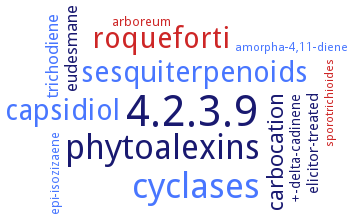4.2.3.9: aristolochene synthase
This is an abbreviated version!
For detailed information about aristolochene synthase, go to the full flat file.

Word Map on EC 4.2.3.9 
-
4.2.3.9
-
cyclases
-
phytoalexins
-
roqueforti
-
capsidiol
-
sesquiterpenoids
-
carbocation
-
eudesmane
-
trichodiene
-
elicitor-treated
-
+-delta-cadinene
-
arboreum
-
epi-isozizaene
-
amorpha-4,11-diene
-
sporotrichioides
- 4.2.3.9
- cyclases
-
phytoalexins
- roqueforti
- capsidiol
- sesquiterpenoids
-
carbocation
-
eudesmane
- trichodiene
-
elicitor-treated
-
+-delta-cadinene
- arboreum
- epi-isozizaene
- amorpha-4,11-diene
- sporotrichioides
Reaction
Synonyms
5-epi-aristolochene synthase, Ari1, aristolochene synthase, AS, ATAS, cyclase, farnesyl pyrophosphate, EAS, EC 2.5.1.40, EC 4.1.99.7, farnesylpyrophosphate cyclase, FPP-carbocyclase, sesquiterpene cyclase, synthase, aristolochene, TEAS
ECTree
Advanced search results
Crystallization
Crystallization on EC 4.2.3.9 - aristolochene synthase
Please wait a moment until all data is loaded. This message will disappear when all data is loaded.
crystallization by the hanging drop, vapor diffusion method at 4°C, the crystal structure determined from crystals soaked with farnesyl diphosphate reveals the binding of intact farnesyl diphosphate to monomers A-C, and the binding of diphosphate anion and Mg2+ to monomer D. The structure of the complex with 2-fluorofarnesyl diphosphate reveals 2-fluorofarnesyl diphosphate binding to all subunits of the tetramer, with Mg2+B accompanying the binding of this analogue only in monomer D. The structure of the complex with 12,13-difluorofarnesyl diphosphate reveals the binding of intact 12,13-difluorofarnesyl diphosphate to monomers A-C in the open conformation and the binding of diphosphate anion, Mg2+B, and Mg2+C to monomer D in a predominantly closed conformation
molecular dynamics simulations based on structure PDB entry 2OA6. The substrate farnesyl diphosphate binds first, followed by three magnesium ions in sequence, and, after reaction, the release of aristolochene and two magnesium ions followed by the final magnesium ion and diphosphate. Binding of farnesyl diphosphate leads to an increased level of sampling of open conformations, allowing the first two magnesium ions to bind. The closed enzyme conformation is maintained with a diphosphate moiety and two magnesium ions bound. The open-to-closed transition reduces flexibility around the active site entrance, partly through a lid closing over it
the structure of recombinant aristolochene synthase at a resolution of 2.2 A and its complex with diphosphate and three Mg2+ ions at 2.15 A is reported
wild type and mutant enzymes in complex with (2E,6E)-farnesyl diphosphate or 4, sitting drop vapor diffusion method, using 20% PEG 3350 as precipitant
X-ray crystal structure of aristolochene synthase complexed with three Mg2+ ions and the unreactive substrate analogue farnesyl-S-thiolodiphosphate, showing that the substrate diphosphate group is anchored by metal coordination and hydrogen bond interactions. The binding conformation of farnesyl-S-thiolodiphosphate directly mimics that expected for productively bound farnesyl diphosphate, with the exception of the precise alignment of the C-S bond with regard to the C10-C11 pi system that would be required for C1-C10 bond formation in the first step of catalysis. Crystal structures of aristolochene synthase complexed with Mg2+3-diphosphate and ammonium or iminium analogues of bicyclic carbocation intermediates proposed for the natural cyclization cascade show various binding orientations for these bicyclic analogues, which appear to be driven by favorable electrostatic interactions between the positively charged ammonium group of the analogue and the negatively charged diphosphate anion. The active site is sufficiently flexible to accommodate analogues with partially or completely incorrect stereochemistry
2.5-A resolution crystal structure of recombinant enzyme, hanging drop method
-


 results (
results ( results (
results ( top
top





